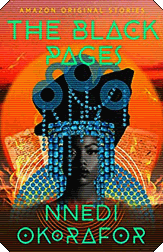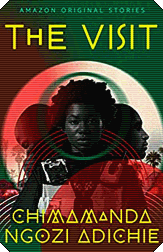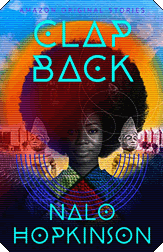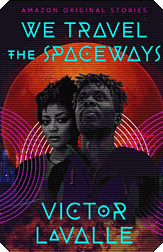Black Stars
An Amazon Original Short Story Series
Exclusively for Kindle from Amazon (for now at least). Free for Prime readers, or 99˘ each for others. Links are on the individual titles. A purchase through our links may earn us a commission.
Reviewed by Galen Strickland
Posted September 10, 2021
Not an anthology per se, since the six stories are available separately, and even though they are numbered at Amazon they can be read in any order. Anyone who has been paying attention to Black SF authors in recent years will recognize most of the names. The newest is C. T. Rwizi, whose first novel was published last year, its sequel this year, with another on the way. The others are well established, with many award wins and nominations between them. Just as everyone should be reading more women authors, they should also be reading more people of color. Do not think you can't relate to different perspectives. We are all human, subject to the same needs, wants, and desires, victims of the same fears, worries, and anxieties. These stories may come from other experiences, but the more you can relate to others the richer your life will be.
 |
As I said above, the stories can be read in any order, but I read them and will discuss them here in the order as they are presented at Amazon. I've reviewed two previous books by Nisi Shawl, the novel Everfair, and the collection Talk Like a Man. In addition to their fiction, they have also written essays on the history of Black science fiction, among other topics, as well as conducting online classes on "Writing the Other." 2043 (A Merman Should I Turn To Be) is set in the titular year, and while it features future tech, it also harks back to previous struggles by Black Americans.
You should be familiar with the phrase "Forty acres and a mule" in relation to slaves freed after the Civil War. In this future world the acreage granted is underwater, and specific to this story it is in the Atlantic off the coast of South Carolina. The coastlines are different from current day, and the first plots granted just off the coast might have included existing buildings, but further out new materials are being used to construct new living facilities. The mule in this case is an underwater motor craft used for personal travel and hauling materials. A combination of genetic manipulation and surgery enables people to live for longer periods underwater. The main characters are members of a theatrical troupe, Pretzles, who come to claim their acreage as well as to perform their plays and musical productions.
As had happened to Blacks in the late 19th Century, there are vigilante groups, "coast guards," that harass and intimidate the underwater dwellers, from boats or helicopters. This includes shooting them with tranquilizer darts and destroying property. The Pretzles first performance is interrupted by such an attack, the survivors aided by long-time residents who have spread out farther and deeper than authorities realize. They have hidden their activities by altering their communications frequencies, keeping the official ones for rudimentary reports, using others to hide the extra work. Adaptation and cooperation enable them to defy the law, and to subvert the expectations of what is possible to accomplish in the new underwater world. Another similarity to the past are those who want to remain within legal boundaries, contrasted with those who know that will stifle their creativity, and their freedom. Just because something is legal doesn't mean it is fair and equitable. This story is sufficient on its own, but I'd love to see a follow-up concerning how much more they could build in the decades ahead.
 |
If you're not familiar with the work of Nnedi Okorafor that will hopefully change soon. HBO is adapting Who Fears Death, and Binti is in the works at Hulu, and hopefully neither will be trapped in development hell. The Black Pages is set in Tombouctou (Timbuktu), Mali, on the day Al-Qaeda comes to town. Their mission is to burn books, other than the Quran at least, and kill or harass anyone who defies their strict interpretation of the Prophet's teachings. In one library the flames free a djinn, Faro, who had been imprisoned in an ancient book, one whose pages are all black. They are able to fly away with the book, and they take refuge in the backpack of a man, Issaka, just returned on winter break from his studies in America. Faro's magic is able to power up Issaka's iPad and phone, also enabling them to connect to the internet and phone network, even though all services are down for everyone else. Issaka discovers his father is among those who had taken many important books from the library before Al-Qaeda struck, and they are hidden in Issaka's old bedroom.
Issaka's mother is also involved, or at least knowledgeable about what is going on, and when Al-Qaeda shows up at their door she is able to help Issaka escape. She somehow also knows about the djinn, and the implication is that Issaka is the reincarnated author of the book with black pages. Why are all the pages black? Apparently it contains a multitude of information on ancient rituals and customs, those that predate Islam or any other current religion. All black since there is no room for spaces between all the words. Can Faro expand the book so that all the words can be read? This story highlights that even devout Muslims are not all a monolithic bloc. Some can follow the Prophet's words without forgetting wisdom that came before, and they aren't so strident in their thinking that they condemn other faiths. No matter that we sometimes forget, the past is always with us, and at times it can be our salvation.
 |
Although I was aware of her and at least one of her award-winning novels, I had previously not read anything by Chimamanda Ngozi Adichie. Based on some opinions she has recently expressed, which I would consider among those held by TERFs, I originally hesitated to read this. But it was free for me, and only 20 pages, so I gave The Visit a chance. It's sort of a reverse feminist tale, set in a future Nigeria (or an alternate history) in which women dominate society, and men are subservient. Obinna is a shy, obedient, stay-at-home husband, while his wife Amana's banking career flourishes. She often comes home late from meetings, sometimes very, very late, or goes out again for dinner meetings, and travels for work a lot. Obinna is sure she is having affairs, but refrains from complaining because that's just the way things are.
Eze is an old friend of Obinna's who has studied and worked in the US for many years, but he comes back for a visit. A similar political structure exists in America, but Eze does not feel as restricted. However, both complain about the anti-male-masturbation laws that have been enacted. What's a man to do when he has no control over his fate? Even if he wears pants, he doesn't wear the pants in the family, if you catch my drift. It's my least favorite of the stories, lifeless and inconsequential, not portraying Amana any differently than a chauvinistic man, and Obinna too weak-willed to do anything about it. My recommendation is to skip it.
 |
C. T. Rwizi was born in Zimbabwe, grew up in Swaziland, finished high school in Costa Rica, got a BA in government at New Hampshire's Dartmouth College, and currently lives in South Africa. I haven't found information about his age, but I know he is the youngest author represented here. He published his first novel, Scarlet Odyssey, last year. I have it but haven't read it yet, thus I passed on the opportunity of getting an ARC of the sequel that came out in May this year. Based on the strength of this story I need to get to that novel soon. It's not that it does anything new, it utilizes familiar tropes, but it packs a lot of world-building in just 24 pages. These Alien Skies is about Msizi, a pilot, and his co-pilot and engineer Tairo, on a mission for the African Union Space Command. They pass through a newly constructed Einstein-Rosen Bridge in order to survey a planet deemed to be habitable by humans. Shortly after the transit, the wormhole is mysteriously destroyed and their spacecraft damaged, but they are able to land.
Msizi has to wear his spacesuit until his systems confirm safety of the atmosphere, but Tairo does not since she is a cyborg (not really). Msizi collapses from what appears to be an allergic reaction, and when he regains consciousness he is in a building that appears to be a hospital, being tended by another human. No, he's not hallucinating. Unknown to the AUSC, a group of people in a generation ship had arrived a hundred or so years before, and they don't like the fact they have been discovered. They want nothing to do with the rest of humanity, but that is based on conditions when they left Earth. Can Msizi convince them things have changed enough to re-connect? The planet has some unique properties, which could benefit all humanity if the colonists are willing to share. That could prove interesting if he ever follows up on this story, but my favorite thing was the relationship between Msizi and Tairo, and the revelation of her true nature, but I'm not spoiling that. Well worth your time, and the $1 necessary to read in case you aren't a Prime member. You can get the free Kindle app for almost any phone or tablet, or for desktop or laptop.
 |
This collection came to my attention when I was searching for something else to read by Nalo Hopkinson, this year's recipient of the SFWA Grand Master Award. I've reviewed all six of her novels and two collections, so up until this popped up the only others to track down were short stories in other anthologies or not yet collected. Clap Back is about nanotechnology being used for both fashion and art, and in the case of the latter a bit of magic is added. Agnetta Burri's latest clothing line is inspired by a quilt-making project from "Mawi, Mali, something exotic-sounding like that…" Woven into the Forgiveness Quilt are phrases such as "Police came to our school and said if girls wear tight dresses, boys will molest us. I forgive him." Or "Auntie gave me gravy with peanuts in it. I nearly died. I forgive her." In Burri's case, the phrases would be woven into the fabric of her clothes utilizing nanotech, which would be absorbed into the skin of the wearer, and later they would be able to repeat the phrase for several days, until the nanobots were flushed from their system and the phrase would be forgotten. What Burri failed to mention is that she invented the notion of the Forgiveness Quilt, and that other people created the nanobots for her, and she has no idea how they work.
Wenda is an artist working on a project concerning advertising art, product packaging, figurines, tchotchkes, all cariacaturized depictions of Black people; Aunt Jemima, Little Black Sambo, etc. Her performance piece is to draw attention to how Blacks have been trivialized in the past, and the magic she imbues the objects with brings them to life. They march out of the museum and into the world. She later learns they find other objects like themselves, in antique stores or at yard sales, and bring them to life as well. Luckily, Wenda has a way to deactivate them, the process of which comes in handy when Burri's nanobots start replicating themselves beyond her ability to control them. Burri is arrested and tried for fraud and negligence, and perhaps Wenda's art career takes off, but that remains to be seen, perhaps in a future story.
 |
Adichie's story is the only one I can't recommend, but it's difficult deciding which is my favorite. Victor LaValle's We Travel the Spaceways is definitely in the running for that honor. It's also the longest of the stories, 40 pages, which might make it close to novelette length. Is it science fiction, or is it fantasy, or is it just the ravings of a disturbed, homeless man in New York? He carries a bag full of cans and bottles with him wherever he goes…and they talk to him. They give him directions and tell him the easiest way to break into buildings. Always churches. Where he sets fires. It's always Black churches or mosques, but not White Christian churches for some reason.
Interspersed between his pyrotechnic exploits, he experiences other hallucinations (or memories?) of being on a space mission observing the impending supernova of the star UY Scuti, in the Scutum Constellation. Is he just crazy? Is he even in New York? Perhaps he's still on that spaceship. If it's the latter, then what are we to make of Kim, a trans woman he meets in a restaurant, spends time with, even has her helping him break into a mosque. Is she crazy too, or is she part of the same space expedition, here to help him come back to reality? I can't answer any of those questions, but it's still a great story. Intriguing, puzzling, heart-breaking, but also a bit of an inspiration.
All together the stories amount to about 170 pages. Each are quick reads, but contain plenty of ideas and concepts to ponder. If you have to buy them they add up to just $5.94 plus applicable tax. This just scratches the surface of all the dynamic writing being done by Black authors, and I know there are many others working in genres beyond SF/F. Don't short-change yourself by ignoring these talented people.
We would appreciate your support for this site with your purchases from Amazon.com, Bookshop.org, and ReAnimusPress.